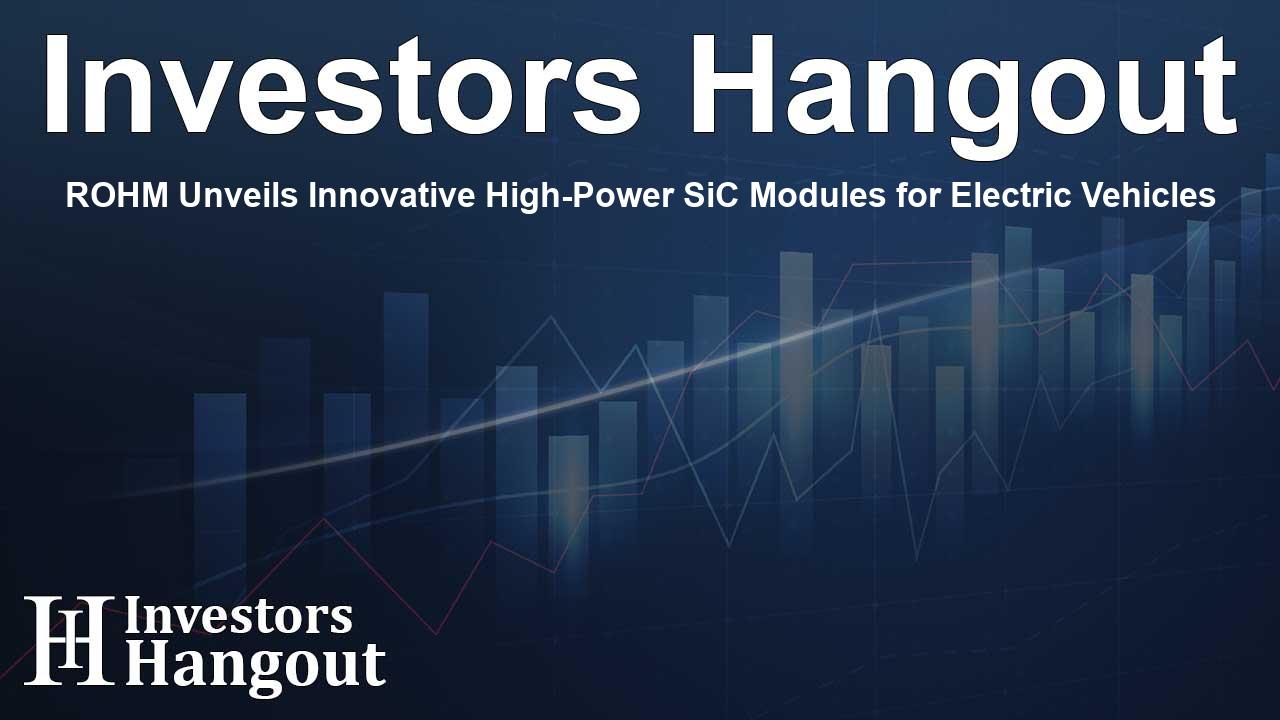ROHM Unveils Innovative High-Power SiC Modules for Electric Vehicles

Introduction to ROHM's New SiC Power Modules
ROHM Co., Ltd. has recently launched a groundbreaking series of high-power-density SiC molded modules in response to the escalating demands in the electric vehicle (xEV) market. These new 4-in-1 and 6-in-1 modules, housed in the HSDIP20 package, are specifically designed for power-factor-correction (PFC) circuits and LLC-resonant converters, which are essential components of onboard chargers (OBC) used in electric vehicles.
Key Features of the HSDIP20 Modules
The new lineup includes six models rated at 750V (BSTxxx1P4K01) and seven at 1200V (BSTxxx2P4K01). These modules integrate vital power conversion circuits, delivering a more compact solution that minimizes design challenges and promotes the miniaturization of onboard chargers. This innovation is a significant step forward, especially in the context of the global push for sustainable transportation—providing vehicle manufacturers with the tools they need to develop more efficient electric powertrains.
Thermal Management and Performance
As interest in electric vehicles continues to surge, automakers are increasingly opting for higher battery voltages to enhance the driving range and expedite charging processes. This trend correlates with a rising demand for compact and high-output onboard chargers and lightweight DC-DC converters. However, achieving higher power density in power electronics often presents challenges regarding heat dissipation. Traditional discrete-based designs frequently encounter thermal management issues, which can jeopardize performance.
ROHM’s innovative HSDIP20 module addresses these challenges effectively. Built with an insulating substrate that offers exceptional heat dissipation, the HSDIP20 maintains lower chip temperatures, even under high-power conditions. For instance, in an actual application involving a PFC circuit, the HSDIP20 consistently operated around 38 degrees Celsius cooler compared to a discrete configuration comprising six devices. Such impressive thermal performance enables the HSDIP20 to support a higher current in a compact form factor, representing over three times the power density of conventional top-side cooled discrete designs and 1.4 times that of similar DIP modules.
Benefits of the HSDIP20 in Electric Powertrain Design
The advantages of the HSDIP20 are clear when it comes to reducing the mounting area. In PFC circuits, the HSDIP20 package can diminish mounting space by approximately 52%, greatly aiding in the miniaturization of onboard chargers and other power conversion systems. This compact and efficient design ultimately allows engineers to create smaller and lighter electric powertrains without sacrificing performance.
Future Developments and Support from ROHM
Looking ahead, ROHM plans to expand its range of SiC modules, focusing on designs that achieve both compactness and high efficiency, particularly in automotive silicon carbide intelligent power modules (IPMs). To support the rapid adoption of their HSDIP20 products, ROHM offers comprehensive application support, which includes in-house motor testing facilities, simulations, and thermal design data. Additionally, ROHM has made two evaluation kits available: one for double-pulse testing and another tailored for three-phase full-bridge implementations. These resources facilitate in-depth testing and performance assessments, paving the way for enhanced practical applications in real-world scenarios.
Conclusion
ROHM Co., Ltd. continues to drive innovation in power electronics, particularly for the evolving field of electric vehicles. Their introduction of the HSDIP20 SiC power modules signifies a commitment to improving efficiency and supporting the green mobility transition. With robust application-level support and advanced thermal management, ROHM is well-positioned to meet the challenges of modern power electronics.
Frequently Asked Questions
What are the new features of ROHM's SiC power modules?
ROHM's new SiC power modules include integrated power conversion circuits in a compact design, available in 750V and 1200V ratings.
How do ROHM's HSDIP20 modules improve thermal performance?
The HSDIP20 modules feature an insulating substrate that ensures excellent heat dissipation, resulting in lower chip temperatures compared to discrete designs.
Why is compactness important in electric powertrains?
Compactness allows for smaller and lighter electric powertrains, which enhance vehicle efficiency, performance, and overall functionality.
What application support does ROHM provide for their HSDIP20 products?
ROHM offers in-house motor testing, simulations, thermal design data, and evaluation kits to assist with practical applications of the HSDIP20 modules.
How does the HSDIP20 affect the design workload for engineers?
The integration of essential circuits in the HSDIP20 module simplifies design processes, allowing engineers to focus more on innovation rather than troubleshooting thermal and spatial constraints.
About The Author
Contact Addison Perry privately here. Or send an email with ATTN: Addison Perry as the subject to contact@investorshangout.com.
About Investors Hangout
Investors Hangout is a leading online stock forum for financial discussion and learning, offering a wide range of free tools and resources. It draws in traders of all levels, who exchange market knowledge, investigate trading tactics, and keep an eye on industry developments in real time. Featuring financial articles, stock message boards, quotes, charts, company profiles, and live news updates. Through cooperative learning and a wealth of informational resources, it helps users from novices creating their first portfolios to experts honing their techniques. Join Investors Hangout today: https://investorshangout.com/
The content of this article is based on factual, publicly available information and does not represent legal, financial, or investment advice. Investors Hangout does not offer financial advice, and the author is not a licensed financial advisor. Consult a qualified advisor before making any financial or investment decisions based on this article. This article should not be considered advice to purchase, sell, or hold any securities or other investments. If any of the material provided here is inaccurate, please contact us for corrections.
